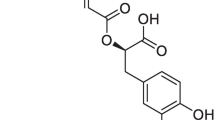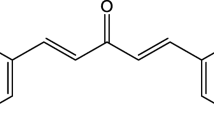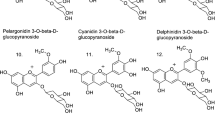Abstract
Antioxidants are important defenders of the human body against nocive free radicals, which are the causative agents of most life-threatening diseases. The immense biomedicinal utility of antioxidants necessitates the development and design of new synthetic antioxidant molecules. The present report deals with the modeling of a series of chromone derivatives, which was done to provide detailed insight into the main structural fragments that impart antioxidant activity to these molecules. Four different quantitative structure–property relationship (QSAR) techniques, namely 3D pharmacophore mapping, comparative molecular similarity indices analysis (CoMSIA 3D-QSAR), hologram QSAR (HQSAR), and group-based QSAR (G-QSAR) techniques, were employed to obtain statistically significant models with encouraging external predictive potentials. Moreover, the visual contribution maps obtained for the different models signify the importance of different structural features in specific regions of the chromone nucleus. Additionally, the G-QSAR models determine the composite influence of pairs of substituent fragments on the overall antioxidant activity profiles of the molecules. Multiple models with different strategies for assessing structure–activity relationships were applied to reach a unified conclusion regarding the antioxidant mechanism and to provide consensus predictions, which are more reliable than values derived from a single model. The structural information obtained from the various QSAR models developed in the present work can thus be effectively utilized to design and predict the activities of new molecules belonging to the class of chromone derivatives.

Schematic diagram showing different features at various positions favoring the antioxidant activity profiles of the chromone derivatives, as well as the different QSAR techniques adopted to reach the conclusions










Similar content being viewed by others
References
Proctor PH (1989) Free radicals and human disease. In: Miquel J (ed) CRC handbook of free radicals and antioxidants in biomedicine. CRC Press, Boca Raton, pp 209–221
Prasad K, Kalra J (1993) Oxygen free radicals and hypercholesterolemic atherosclerosis: effect of vitamin E. Am Heart J 125:958–973
Balazas L, Leon M (1994) Evidence of an oxidative challange in the Alzheimer's brain. Neurochem Res 19:1131–1137
Cooke MS, Evans MD, Dizdaroglu M, Lunec J (2003) Oxidative DNA damage: mechanisms, mutation, and disease. FASEB J 17:1195–1214
Langseth L (1996) Oxidants, antioxidants and disease prevention. International Life Science Institute, Brussels
Cadenas E, Davies KJ (2000) Mitochondrial free radical generation, oxidative stress, and aging. Free Radical Biol Med 29:222–230
McCord JM (1998) Iron, free radicals, and oxidative injury. Semin Hematol 35:5–12
Gordon MH (1990) The mechanism of antioxidant action in vitro. In: Hudson BJF (ed) Food antioxidants. Elsevier, New York, pp 1–18
Singh BK, Sharma SR, Singh B (2010) Antioxidant enzymes in cabbage: variability and inheritance of superoxide dismutase, peroxidase and catalase. Sci Hort 124:9–13
Wright JS, Johnson ER, DiLabio GA (2001) Predicting the activity of phenolic antioxidants: theoretical method, analysis of substituent effects, and application to major families of antioxidants. J Am Chem Soc 123:1173–1183
Vafiadis AP, Bakalbassis EG (2005) A DFT study on the deprotonation antioxidant mechanistic step of ortho-substituted phenolic cation radicals. Chem Phys 316:195–204
Musialik M, Litwinienko G (2005) Scavenging of DPPH• radicals by vitamin E is accelerated by its partial ionization: the role of sequential proton loss electron transfer. Org Lett 7:4951–4954
Genestra M (2007) Oxyl radicals, redox-sensitive signaling cascades and antioxidants. Cell Signal 19:1807–1819
Dizdaroglu M, Jaruga P, Birincioglu M, Rodriguez H (2002) Free radical-induced damage to DNA: mechanisms and measurement. Free Radic Biol Med 32:1102–1115
Helguera AM, Combes RD, Gonzalez MP, Cordeiro MN (2008) Applications of 2D descriptors in drug design: a DRAGON tale. Curr Top Med Chem 8:1628–1655
Gonzalez MP, Teran C, Saiz-Urra L, Teijeira M (2008) Variable selection methods in QSAR: an overview. Curr Top Med Chem 8:1606–1627
Hansch C, Maloney PP, Fujita T, Muir RM (1962) Correlation of biological activity of phenoxyacetic acids with Hammett substituent constants and partition coefficients. Nature 194:178–180
Cheng Z, Ren J, Li Y, Chang W, Chen Z (2002) Study on the multiple mechanisms underlying the reaction between hydroxyl radical and phenolic compounds by qualitative structure and activity relationship. Bioorg Med Chem 10:4067–4073
Singh N, Loader RJ, O’Malley PJ, Popelier PLA (2006) Computation of relative bond dissociation enthalpies (DBDE) of phenolic antioxidants from quantum topological molecular similarity (QTMS). J Phys Chem A 110:6498–6503
Reis M, Lobato B, Lameira J, Santos AS, Alves CN (2007) A theoretical study of phenolic compounds with antioxidant properties. Eur J Med Chem 42:440–446
Mitra I, Saha A, Roy K (2009) Quantitative structure–activity relationship modeling of antioxidant activities of hydroxybenzalacetones using quantum chemical, physicochemical and spatial descriptors. Chem Biol Drug Des 73:526–536
Mitra I, Roy K, Saha A (2009) QSAR of antilipid peroxidative activity of substituted benzodioxoles using chemometric tools. J Comput Chem 30:2712–2722
Mitra I, Saha A, Roy K (2010) Pharmacophore mapping of arylamino-substituted benzo[b]thiophenes as free radical scavengers. J Mol Model 16:1585–1596
Roy K, Mitra I (2009) Advances in quantitative structure–activity relationship models of antioxidants. Expert Opin Drug Discov 4:1157–1175
Samee W, Nunthanavanit P, Ungwitayatorn J (2008) 3D-QSAR investigation of synthetic antioxidant chromone derivatives by molecular field analysis. Int J Mol Sci 9:235–246
Samee W, Sae-Lee N, Ungwitayatorn J (2004) Structure-radical scavenging activity relationships of the synthesized chromone derivatives. J Pharm Sci 9:36–42
Leonard JT, Roy K (2006) On selection of training and test sets for the development of predictive QSAR models. QSAR Comb Sci 25:235–251
Roy PP, Leonard JT, Roy K (2008) Exploring the impact of the size of training sets for the development of predictive QSAR models. Chemom Intell Lab Sys 90:31–42
SPSS Inc. (2011) SPSS. SPSS Inc., Chicago. http://www.spss.com
Smellie A, Teig SL, Towbin P (1995) Poling: promoting conformational variation. J Comput Chem 16:171–187
Accelrys Inc (2010) Cerius 2, v.4.10. Accelrys Inc., San Diego
Sutter J, Guner OF, Hoffman R, Li H, Waldman M (2000) HypoGen: an automated system for generating 3D predictive pharmacophore models. In: Guner OF (ed) Pharmacophore perception, development, and use in drug design. International University Line, La Jolla, pp 501–511
Mitra I, Saha A, Roy K (2010) Exploring quantitative structure–activity relationship (QSAR) studies of antioxidant phenolic compounds obtained from traditional Chinese medicinal plants. Mol Simul 36:1067–1079
Golbraikh A, Tropsha A (2002) Beware of q 2! J Mol Graph Mod 20:269–276
Roy PP, Roy K (2008) On some aspects of variable selection for partial least squares regression models. QSAR Comb Sci 27:302–313
Roy PP, Paul S, Mitra I, Roy K (2009) On two novel parameters for validation of predictive QSAR models. Molecules 14:1660–1701
Mitra I, Roy PP, Kar S, Ojha PK, Roy K (2010) On further application of \( {\text{r}}_{\text{m}}^{{2}} \) as a metric for validation of QSAR models. J Chemometrics 24:22–33
Ojha PK, Mitra I, Das RN, Roy K (2011) Further exploring \( {\text{r}}_{\text{m}}^{{2}} \) metrics for validation of QSPR models. Chemom Intell Lab Syst 107:194–205
Cramer RD III, Patterson DE, Bunce JD (1988) Comparative molecular field analysis (CoMFA). Effect of shape on binding of steroids to carrier proteins. J Am Chem Soc 110:5959–5967
Klebe G, Abraham U, Mietzner T (1994) Molecular similarity indices in a comparative analysis (CoMSIA) of drug molecules to correlate and predict their biological activity. J Med Chem 37:4130–4146
Streitwieser A (1961) Molecular orbital theory for organic chemists. Wiley, New York
White DNJ (1977) The principles and practice of molecular mechanics calculations. Comput Chem 1:225–233
Kirkpatrick S, Gelatt CD, Vecchi MP Jr (1983) Optimization by simulated annealing. Science 220:671–680
Tripos Inc. (2006) SYBYL 7.3. Tripos Inc., St. Louis. http://www.tripos.com
Wold S, Albano C, Dunn WJ III, Esbensen K, Hellberg S, Johansson E, Sjostrom M, Edlund U, Geladi P (1984) Multivariate data analysis in chemistry. In: Kowalski B (ed) Chemometrics: mathematics and statistics in chemistry. Reidel, Dordrecht
Hoskuldsson A (1987) PLS regression methods. J Chemometrics 2:211–228
Clark RD, Fox PC (2004) Statistical variation in progressive scrambling. J Comput Aided Mol Des 18:563–576
Doddareddy MR, Lee YJ, Cho YS, Choi KI, Koh HY, Pae AN (2004) Hologram quantitative structure activity relationship studies on 5-HT6 antagonists. Bioorg Med Chem 12:3815–3824
Wold S, Johansson E, Cocchi M (1993) PLS: partial least squares projections to latent structures. In: Kubiniyi H (ed) 3D QSAR in drug design: theory, methods and applications. ESCOM, Leiden, pp 523–550
Ajmani S, Jadhav K, Kulkarni SA (2009) Group-based QSAR (G-QSAR): mitigating interpretation challenges in QSAR. QSAR Comb Sci 28:36–51
VLife Sciences Technologies Pvt. Ltd. (2007) VLife MDS 3.5. VLife Sciences Technologies Pvt. Ltd., Pune. http://www.vlifesciences.com
Darlington RB (1990) Regression and linear models. McGraw-Hill, New York
Snedecor GW, Cochran WG (1967) Statistical methods. Oxford & IBH, New Delhi
Stephens MA (1976) Asymptotic results for goodness-of-fit statistics with unknown parameters. Ann Stat 4:357–369
Massey FJ Jr (1951) The Kolmogorov–Smirnov test for goodness of fit. J Am Stat Assoc 46:68–78
Lilliefors HW (1967) On the Kolmogorov–Smirnov test for normality with mean and variance unknown. J Am Stat Assoc 64:399–402
Gramatica P (2007) Principles of QSAR models validation: internal and external. QSAR Comb Sci 26:694–701
Eriksson L, Jaworska J, Worth AP, Cronin MT, McDowell RM, Gramatica P (2003) Methods for reliability and uncertainty assessment and for applicability evaluations of classification- and regression-based QSARs. Environ Health Perspect 111:1361–1375
Patrick GL (2009) An introduction to medicinal chemistry. Oxford University Press, New York
Wang R, Gao Y, Lai L (2000) Calculating partition coefficient by atom-additive method. Perspect Drug Discov 19:47–66
Todeschini R, Consonni V, Maiocchi A (1999) The K correlation index: theory development and its applications in chemometrics. Chemom Intell Lab Syst 46:13–29
Todeschini R (1997) Data correlation, number of significant principal components and shape of molecules. The K correlation index. Anal Chim Acta 348:419–430
Umetrics AB (2002) SIMCA-P 10.0. Umetrics AB, Umea. http://www.umetrics.com
Golbraikh A, Shen M, Xiao ZY, Xiao YD, Lee KH, Tropsha A (2003) Rational selection of training and test sets for the development of validated QSAR models. Comput Aided Mol Des 17:241–253
Zhu H, Tropsha A, Fourches D, Varnek A, Papa E, Gramatica P, Oberg T, Dao P, Cherkasov A, Tetko IV (2008) Combinatorial QSAR modeling of chemical toxicants tested against Tetrahymena pyriformis. J Chem Inf Model 48:766–784
Acknowledgments
This research work is supported in the form of a major research project to K.R. and a senior research fellowship to I.M. by the Indian Council of Medical Research (ICMR), New Delhi. We thank the anonymous reviewers for useful comments. The authors thank VLife Sciences Technologies Pvt. Ltd., Pune for providing complimentary evaluation license of the software VLife MDS 3.5.
Author information
Authors and Affiliations
Corresponding author
Electronic supplementary material
Below is the link to the electronic supplementary material.
ESM 1
(DOC 511 kb)
Rights and permissions
About this article
Cite this article
Mitra, I., Saha, A. & Roy, K. Development of multiple QSAR models for consensus predictions and unified mechanistic interpretations of the free-radical scavenging activities of chromone derivatives. J Mol Model 18, 1819–1840 (2012). https://doi.org/10.1007/s00894-011-1198-x
Received:
Accepted:
Published:
Issue Date:
DOI: https://doi.org/10.1007/s00894-011-1198-x




